- 1. Snow Camping Equipment and Setup
- 1.1. Choose the right tent and accessories
- 1.2. Sleeping pads
- 1.3. Sleeping bag
- 1.4. High-altitude, cold weather cookstoves
- 1.5. Hydration system... and then some
- 1.6. High-energy food
- 1.7. Snow shovel
- 1.8. Gear sled
- 1.9. Backcountry first aid kit
- 2. Choose the Right Outdoor Clothing
- 3. Where To Go
- 3.1. Winter Camping in Utah
- 3.2. Cold Comfort in Colorado
- 3.3. Washington's Winter Wonderland
- 4. Be Prepared, Stay Safe, and Have Fun
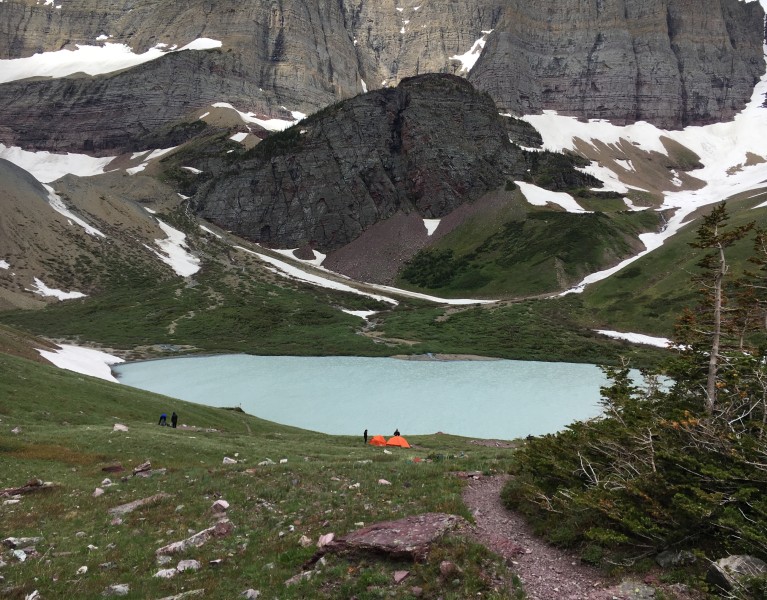
The Snow Camping Challenge: Preparing for Winter in the Backcountry
Table of Contents [Show]
When I was a kid, my brother and I were each in "outdoor" youth programs. I won't name the organizations, but his group, with my dad as the leader, got to do all sorts of fun stuff—learning to make fire using a bow drill, rappelling, spelunking, and tracking—while we girls got stuck sewing cushions so we'd have something to sit on while we learned to crochet, or made cheesy beaded jewelry.
I resented all the things my brother got to do, but when I found out his troop was going winter camping in the snow, I pointed and laughed. "Sucks to be you!"
My dad, one of the leaders, overheard. Being one never to let a teachable moment slide, he conferred with the parents of his troop and announced that I was welcome to come along. I honestly think he figured I'd finally stop complaining about the disparity between male and female scouting activities if I had a miserable experience.
As it turns out, I had a fantastic time, and Dad learned as much as we did: Girls deserve to learn about outdoor adventures, just as much as boys. We're up for the tough challenges. And now that I'm a so-called "grownup," I love to help the people in my life push their boundaries with winter camping. These basic tips can get you away from the Bedazzler and out into the backcountry:
Snow Camping Equipment and Setup
Anybody who tells you they had an awful experience with winter camping either didn't check the weather, brought the wrong gear or didn't know how to use the right gear correctly. As with any outdoor sport, plan ahead and prepare accordingly.
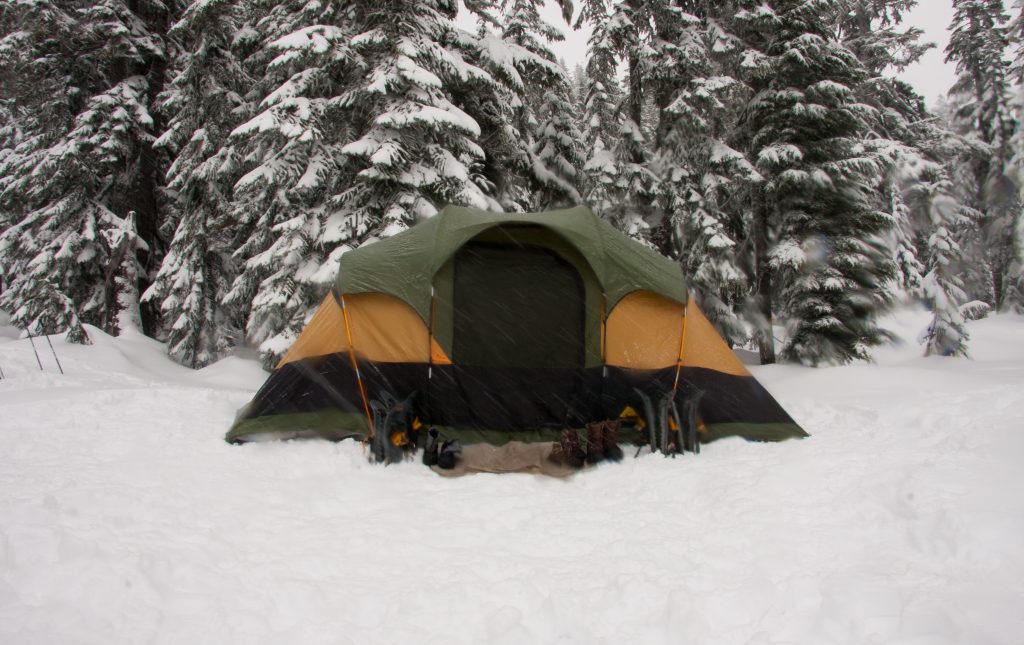
Photo by frigid. Location: Stevens Pass, United States.
Choose the right tent and accessories
Unless you plan to build a snow cave, you're going to want a four-season tent. Choose one with a large vestibule in front in which to store pointy stuff like Yaktrax, crampons, snowshoes, and axes so they won't rip a hole in the tent floor or, for that matter, your tent buddy.
Four season (Alpine) tents have stronger poles to support snow loads and winds, have limited breathability and ventilation to retain heat, and generally, more tie-down points. You can get away with a three-season tent if you're absolutely sure you won't be dumped on in the night, but if you're looking for a one-and-done tent for most situations, a salesperson at a reputable mountaineering shop can tell you which 3-season tents they consider "3+."
Be sure to swap out your stock tent spikes with snow or sand spikes; these provide better grip in packed snow. You can buy fabric "snow anchors" to fill with rocks or packed snow, or tie your guy lines to pieces of wood, bury them, and pack snow on top. That's the "dead man" technique, and my personal favorite if I'm camping in deep snow.
Here are some more set-up tips for your tent:
- Learn how to correctly pitch your tent before you head out on your trip. Select a site on a natural bench, away from potential avalanches. I'm thinking of getting some affordable tech to help me choose the safest spots, and because I'm a self-proclaimed "gadget girl."
- Avoid windy ridges. If your tent is long and narrow, pitch it with the smaller dimension into the wind, and if possible, the door and vestibule downwind.
- Don't set up under large tree branches, since snow and ice accumulation can cause them to break or dump snow on your tent.
- Pack down the snow under your tent site, leaving at least six inches around the perimeter for air circulation.
- Dig out a "footwell" under your vestibule so you can sit on the edge of your tent and put on your boots. Heavy clothing makes it awkward to bend over and tie laces or put on traction devices without flailing around and kicking snow everywhere. This I say from personal experience.
One last thing about choosing the right tent: It's always handy to have a little extra headroom and floor space in case you're hunkered down in bad weather, but larger tents don't retain body heat as much as backpacking-sized models do. I once spent a few nights on the Canadian tundra in an 8 x 16 Quonset-style tent meant to house six people, and with only three of us (and an enormous catalytic heater), we were absolutely miserable.
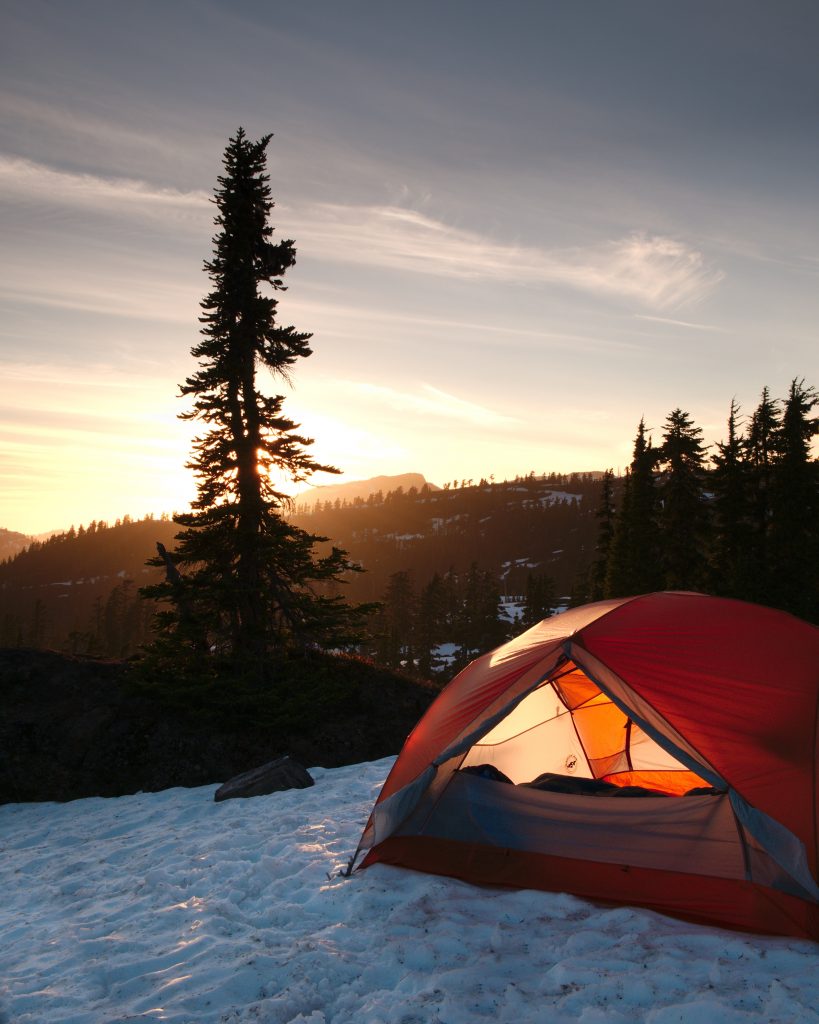
Photo by Eddie Lawhead. Location: Strathcona Provincial Park, Canada.
Sleeping pads
Most winter camping experts will tell you to bring two sleeping pads. Those who don't are still frozen to the surface of a glacier somewhere. I prefer to use a closed-cell foam backpacking pad under an inflatable pad for the best insulation and comfort. Under these, I put an orange, reflective thermal tarp. The cold ground will actually suck the heat right out of you, so what you sleep on is at least as important as what you sleep under.
Sleeping bag
Choose a sleeping bag that's rated for temperatures at least 10°F colder than the lowest temps in your camping area, and consider bringing along a sleeping bag liner to add some extra warmth if you need it. Liners also reduce wear on your sleeping bag, since they're easily washed.
This might be a good time to mention that you shouldn't wear too many layers to bed. I like to wear a lightweight, wicking base layer so that if I sweat, the moisture will be drawn away from my body, but my circulation isn't restricted.
High-altitude, cold weather cookstoves
Most any backpacking stove will do at lower elevations, but if you're headed above the treeline, you'll want a stove that compensates for lower oxygen levels and reduced air pressure. Liquid fuels do better than propane in cold weather, too. My favorite stove is the Primus OmniFuel, which I use with white gas (though, in a pinch, you can siphon off some jet fuel or diesel).
No matter what you've seen in movies or adventure reality shows, never use your cooking stove inside your tent. Carbon monoxide buildup can kill you. Heat your water and your meals outside. I avoid cooking in my vestibule, though some mountaineers I know will close their tent up and open their vestibule flap.
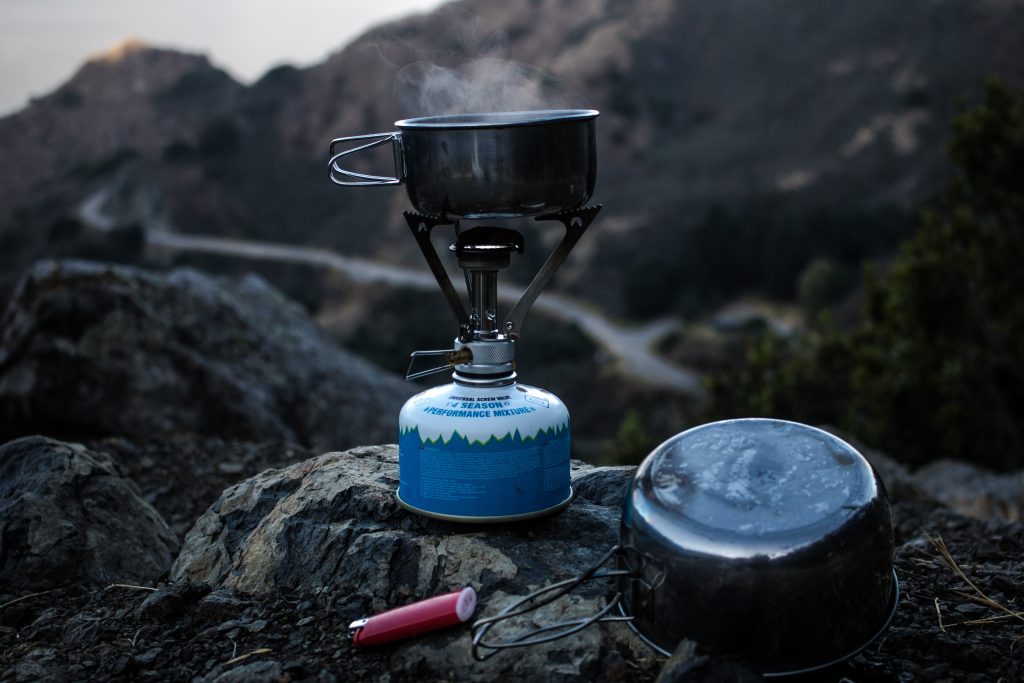
Photo by Sage Friedman. Location: Big Sur, United States.
Hydration system... and then some
If your outdoor performance clothing is doing its job, then you won't notice how much you're perspiring when you're making your way to your camping spot. Be sure to drink plenty of water, and melt and boil snow at camp, so you have enough for the evening and the next day. Don't bring reservoir water systems, as the tubes can freeze up; use polycarbonate bottles that can hold hot or boiling water.
Speaking of... sacrifice a container or two as your "pee bottle." If you're hydrating properly, nature might call in the middle of the night and—trust me—you don't want to have to wrestle your sleeping bag, heavy outdoor clothing, and boots if you have to go right now. To my fellow ladies, some advice: Invest in a highly-rated "pee funnel" to level the playing field. Female mountaineers, small-craft pilots, truck drivers, and Netflix bingers all know what I'm talking about.
High-energy food
When it's cold outside, you need to consume more calories than you're used to. Keep yourself fueled up with energy-dense snack bars, peanuts, chocolate, and granola throughout the day, and opt for dehydrated meals with the most carbs. Chances are, the bears in your area aren't active, so it's reasonably safe to chow down on a snack right before you go to bed.
Snow shovel
Do you want to dig out that vestibule pit? Maybe excavate and sculpt an outdoor kitchen and seating area for your group? You'll definitely want a packable snow shovel. I use mine to build up walls around my tent (leaving space for the tent fly to vent) if I expect the wind to kick up, and it makes it easier to dig out or set up deadman anchor points.
Gear sled
If you're snowshoeing or Nordic skiing with your family or a group, you might want to invest in a cargo sled. You'll find them in a wide range of prices and designs, but my Dad got an inexpensive sled for hauling big game, and I promptly stole it from him. I can pull it over bare patches and through snow, and it works just fine. I'm betting it will hold a tired kid or two as well as any gear (or beer) that won't fit in your backpack.
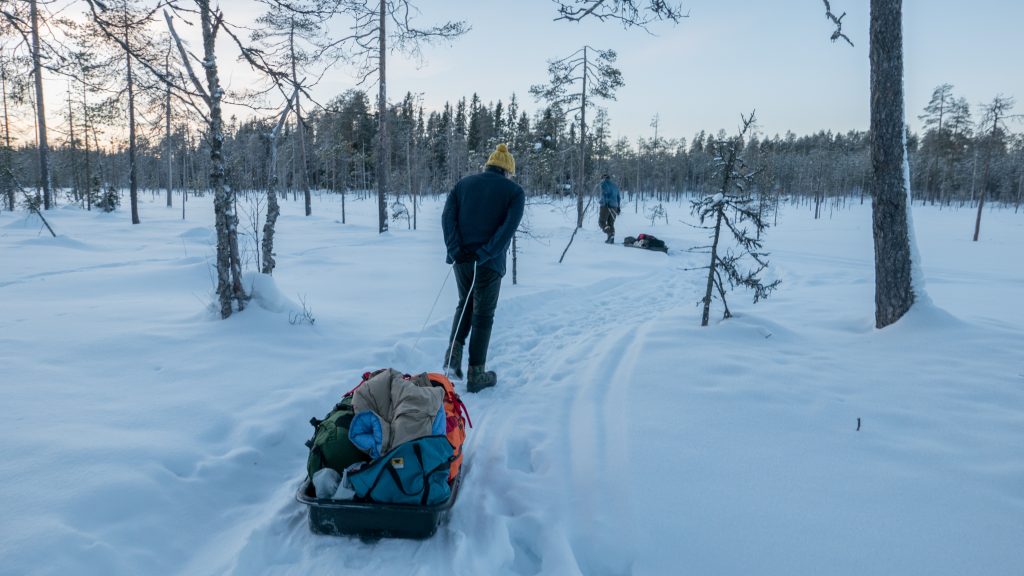
Photo by Wynand van Poortvliet. Location: Lentiira, Finland.
Backcountry first aid kit
It's one thing to get injured in the wilderness, and entirely another when you're out in the backcountry in winter. It takes longer to get back to civilization, and weather might prevent rescuers from reaching you right away. For great recommendations for first aid and emergency supplies, check out our winter survival post. I also recommend you do a little research on winter camping so you can avoid using your kit!
Choose the Right Outdoor Clothing
Trekking to and setting up your backcountry campsite requires effort, which in turn requires appropriate breathable, moisture-wicking outdoor performance clothing. Relaxing in the silent winter landscape means your body won't be generating as much heat to keep you warm. Hanging out in camp is half the fun, and you won't be diving into your down sleeping bag as soon as you pitch camp, so you want to pack the right winter clothing for downtime.
- Medium-weight base layer
- Warm, fluffy fleece mid-layer
- High-loft down coat; be sure it's water-resistant—especially if you're heading out to wetter areas—and be sure it's big enough not to compress when you wear it over your under layers
- Rain jacket or poncho
- Waterproof or water-resistant pants
- Merino wool socks (2 pairs per day)
- Waterproof hiking or snow boots
- Leg gaiters
- Fingerless gloves with "flip over" mittens for in-camp tasks
- Warm wool or fleece hat
- Sunglasses with UV protection
Never allow yourself to sweat. Remove or add layers as you need to, and be sure to change into clean, dry clothes before going to bed. It never hurts to bring more socks than you think you'll need to, an extra hat, and an extra pair of gloves.
Where To Go
The first place you'll want to go winter camping? Someplace close to home so that you can field-test your gear and techniques. If you don't live where nighttime temperatures drop below 40°, congratulations! You now have an excuse to get away for the weekend for a cold-weather camp out where you're not too far from civilization; if things go haywire, you can make a run for a hotel, or at least a sporting goods shop.
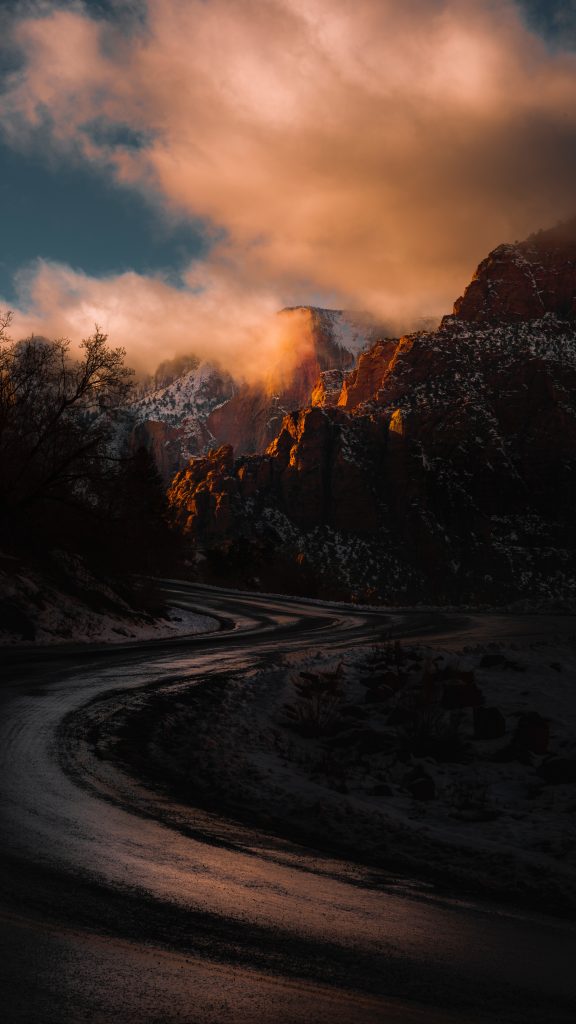
Photo by Daniel Olah. Location: Zion National Park, United States.
Once you're confident that you're properly equipped and have the right food, clothing, and attitude, you're ready to pick your first winter backcountry destination. These happen to be my repeat winter retreats:
Winter Camping in Utah
Southern Utah is one of my favorite playgrounds any time of the year. Those iconic red rocks dusted with snow? Absolutely stunning. The Utah Office of Tourism beckons outdoor enthusiasts to experience their five national parks during winter, but Zion, Bryce Canyon, Canyonlands, Arches, and Capital Reef aren't your only options. You'll find dozens of national monuments, state parks, and other points of interest in southern Utah from which to choose.
Be sure to check out Arches National Park, which was voted the "Prettiest National Park in Winter" by The Wilderness Society. (They're right!)
Cold Comfort in Colorado
If you're going cross-country skiing or snowshoeing in Colorado, you don't have to limit yourself to their top winter trails. Rocky Mountain National Park offers beginner and intermediate ranger-guided tours, and you can grab a permit for backcountry winter camping if their improved campgrounds are beneath your skill level.
Colorado is the "New Mongolia" of the West, thanks to the popularity of yurts. Colorado Parks and Wildlife has a couple for rent, or you can book a remote yurt from a private backcountry resort, such as The Hidden Treasure Yurts on New York Mountain. Nothing wrong with a little "glamping," especially when you need to put in some effort to get there.
Washington's Winter Wonderland
If you plan to thru-hike the Wonderland Trail, you'll likely encounter some snow even in the middle of summer. For a peek into a wintertime snow camping adventure organized by the Pacific Northwest Outdoor Women (PNOW), visit the Every Two Pines blog for a fantastic post with tons of pictures.
Are you looking for more solitude? Check out Jade Lake... hands-down one of the most gorgeous weekend winter trips in the state.
Be Prepared, Stay Safe, and Have Fun
You don't have to climb rock faces, enter Ironman competitions, or get fitted for a wingsuit to challenge your outdoor skills. Earn yourself a merit badge with a wintertime trip to your favorite backcountry camping spot. While you're at it, proclaim it "Take Your Niece/Daughter/Kid Sister Week" and fire up another generation of hardcore outdoor adventurers.
But let the boys come along if they really want to.
Featured image by Matt Thomason.


